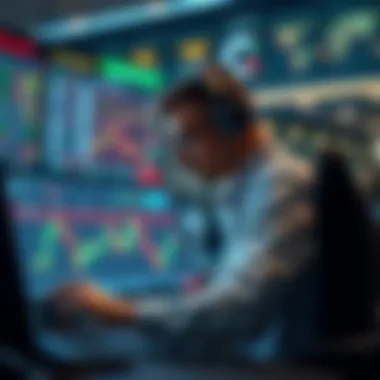Top Crypto Trading Terminals: A Comprehensive Guide


Intro
In the world of cryptocurrency, navigating the trading landscape can feel like trying to find your way through a dense forest without a map. With countless trading terminals available, ranging from sophisticated platforms used by seasoned investors to user-friendly interfaces designed for beginners, the choice can be overwhelming. A crypto trading terminal serves not just as a mere interface for executing trades; it is the lifeline of any investor aiming to make informed decisions in a field that evolves at a breakneck pace.
This guide aims to peel back the layers on the most effective crypto trading terminals. Each terminal is dissected to reveal its key features, user experiences, and the strengths and weaknesses that could affect your trading success. For investors, analysts, developers, and educators, understanding these tools can lead to not just better trades but also a deeper comprehension of market dynamics.
Let's embark on this journey to better equip you with the insights and practical knowledge necessary to navigate the crypto markets effectively.
Crypto Concepts Explained
When diving into crypto trading, grasping the foundational concepts is essential. A solid understanding of terminology and technology will prepare you not only to trade but to make strategic decisions in a constantly shifting environment.
Key Terminology and Definitions
To communicate effectively in the world of crypto, you need to familiarize yourself with some key terms. Here’s a brief rundown:
- Blockchain: A decentralized ledger that records transactions across multiple computers. The remarkable aspect here is that once recorded, these transactions cannot be altered without the consensus of the network.
- Wallet: A digital tool, software, or hardware, used to store your cryptocurrencies securely. Different wallet types offer varying levels of security and accessibility.
- Exchange: A platform that allows you to buy, sell, or trade cryptocurrencies. Think of it as a marketplace where various currencies are exchanged.
- Altcoin: Any cryptocurrency other than Bitcoin. The term implies a wide variety of projects, each boasting unique technologies and use cases.
Practical Applications of Blockchain Technology
Blockchain technology is not limited to cryptocurrency; it has far-reaching applications. By leveraging its capabilities, industries are beginning to shuffle the cards.
- Supply Chain Management: Companies integrate blockchain to improve transparency and traceability, allowing consumers to track products back to their origin, thus preventing fraud.
- Smart Contracts: These self-executing contracts with the terms of the agreement directly written into code mitigate the need for a trusted intermediary.
"Understanding the basic concepts of blockchain can open many doors, as its applications extend beyond finance into various sectors such as healthcare, voting systems, and real estate."
Investment Strategies
Transitioning from foundational knowledge to actionable strategies is where many traders often stumble. With appropriate strategies, you can better navigate the unpredictable waves of the crypto seas.
Analyzing Market Trends and Indicators
Harnessing technical analysis is pivotal for any investor. By examining historical price movements and trading volumes, traders can uncover potential future trends. Look out for signals such as:
- Moving Averages: Indicators that smooth out price data to identify the direction of a trend.
- Relative Strength Index (RSI): A momentum oscillator that measures the speed and change of price movements.
- Fibonacci Retracement Levels: These levels help identify potential support and resistance areas by calculating retracement levels based on the Fibonacci sequence.
Risk Management Techniques
Navigating the crypto realm necessitates a firm grip on risk. Ignoring this can lead to substantial losses. Here are key techniques:
- Diversification: Don't put all your eggs in one basket. Spread your investments across various assets to reduce risk.
- Stop-Loss Orders: Setting these on your trades can help limit losses by automatically selling assets at a predetermined price.
- Position Sizing: Determine how much you are willing to risk on a single trade and adjust your position size accordingly.
Understanding these methods is crucial in fostering a sustainable investment approach. As the crypto market evolves, armed with the right tools and knowledge, you’ll be better positioned to thrive in a volatile environment.
Prolusion to Crypto Trading Terminals
The fast-paced world of cryptocurrency trading can often feel like trying to drink water from a fire hose. With numerous options to consider, tools and platforms vary widely in functionality, accessibility, and user-friendliness. This makes choosing the right crypto trading terminal a pivotal decision for investors at any level.
Defining Crypto Trading Terminals
At its core, a crypto trading terminal is a sophisticated software application designed to facilitate the trading of cryptocurrencies. It streamed real-time market data and critical analysis tools while also linking seamlessly with various exchanges. Unlike basic trading platforms, many terminals offer advanced features such as customizable dashboards, automated trading strategies, and detailed charting options. Investors can leverage these capabilities to maximize their trading efficiency and make informed decisions.
Importance of Choosing the Right Terminal
Making an informed choice about a trading terminal can influence an investor's success. Picking the right one means considering several factors:
- User Experience: An intuitive interface can significantly enhance a trader's comfort, especially for newcomers. A steep learning curve can be a deterrent.
- Security Features: With growing concerns around cybersecurity, the protection of assets is paramount. Evaluating the security protocols of a terminal is non-negotiable.
- Market Analytics: Some terminals provide powerful tools for technical and fundamental analysis, which can lead to better trading strategies.
- Integration: A good terminal should integrate with multiple exchanges to give users access to diverse market options without being tied to one platform.
- Customization: Every trader has unique preferences, and having the ability to tailor a terminal to one’s specific needs can enhance the trading experience.
Investors must weigh these considerations carefully to choose a terminal that aligns with their trading style and strategy.
"The decision to utilize a robust crypto trading terminal can be the difference between stumbling in the dark and strategically navigating through the waves of cryptocurrency markets."
In summary, crypto trading terminals are far more than digital tools; they are enablers of investment strategies. Selecting the right terminal can significantly enhance a trader's capabilities in this dynamic and sometimes unpredictable market.
Key Features of Crypto Trading Terminals


Selecting a crypto trading terminal isn’t just about picking the first option you come across. With the dynamic nature of the cryptocurrency market, having the right terminal can make all the difference in execution speed, access to analytics, and overall trading experience. This section unpacks the critical features that users should consider when assessing different terminals. Each segment focuses on various attributes that contribute to a trader's effectiveness and ease of use.
User Interface and Experience
A terminal's user interface (UI) is the first thing a trader interacts with, and it governs how comfortably you can navigate through the platform. A slick, intuitive UI enhances the overall user experience, allowing traders to execute orders quickly. Think of it as the cockpit of an aircraft; if the controls are complicated and cluttered, it’s hard to fly smoothly.
Here are some important aspects of UI and user experience:
- Clear Navigation: Users should be able to find trading options, account settings, and market data without hunting around.
- Interactive Charts: Real-time data presented in graph form helps traders assess trends quickly.
- Responsive Design: Whether on desktop or mobile, a fast-loading and adaptable interface ensures that one can trade on the go.
In essence, a well-designed terminal is like a comfortable pair of shoes; it might not be flashy, but it will carry you far and make the journey easier.
Security Measures
The world of cryptocurrency is notorious for its volatility and risks, which makes security a top priority for traders. The best terminals come equipped with robust security features to safeguard assets. It's not about whether incidents happen but rather when they occur, hence the necessity for preventive measures.
Key security features to look out for include:
- Two-Factor Authentication (2FA): This adds an extra layer of security, requiring not just a password but a second form of identification.
- Cold Storage Options: A terminal that offers cold storage for keeping cryptocurrency offline provides further security against hacks.
- Regular Security Audits: Understanding whether a terminal has a history of secure operations can offer some peace of mind.
Keeping your assets safe is paramount, so make sure the terminal you choose has the armor to protect your investments.
Market Analysis Tools
To succeed in the fluctuating crypto markets, having immediate access to analytical tools is indispensable. These tools empower traders to make informed decisions instead of relying solely on instinct or hearsay. With effective analysis, one might just catch the next big wave.
Consider these tools essential for your trading arsenal:
- Technical Indicators: Tools like Bollinger Bands, Moving Averages, and Relative Strength Index provide critical insights into market movements.
- Sentiment Analysis Features: Knowing how the market feels about certain coins can help in predicting price movement.
- News Aggregators: Finding a terminal that consolidates relevant news can keep traders informed about potential market movers.
Having a solid set of market analysis tools can turn a novice trader into a seasoned pro, akin to having a GPS while navigating through a labyrinth.
Integration with Exchanges
One of the hallmarks of an effective trading terminal is its ability to integrate seamlessly with various cryptocurrency exchanges. This connectivity allows users to execute trades swiftly and manage different accounts from a single interface. It’s like having a versatile toolbox—each tool is accessible when you need it, allowing for streamlined trading.
Ensure that your terminal supports:
- Multiple Exchange Integrations: The ability to trade on platforms like Binance, Kraken, or Coinbase from within a single terminal can enhance flexibility.
- API Support: A robust API connection can enhance trading efficiency and automation, ideal for algo-traders.
- Real-time Data Transfers: Fast and seamless data transfers between your terminal and the exchange prevent delays in trading execution.
Choosing a terminal that offers strong integration with exchanges can save you time and stress, which are invaluable in the racing world of crypto trading.
Customization Options
Every trader has unique preferences and styles, so having a terminal that allows customization is a significant advantage. Personalization options can tremendously enrich the trading experience.
Look for the following customization features:
- Custom Dashboards: The ability to set up your dashboard according to your trading habits ensures easy access to frequently used tools and data.
- Alerts and Notifications: Setting up price alerts can help traders stay ahead of the game without continuously monitoring the market.
- Theme Settings: While this might seem trivial, a customizable interface can make long hours of trading more bearable and even enjoyable.
A terminal that welcomes customization is like having a tailored suit; it fits better and often feels more comfortable, allowing for improved focus and performance during trading hours.
Top Crypto Trading Terminals Reviewed
When it comes to engaging in trading within the cryptocurrency space, selecting the right terminal is crucial. Each trading terminal brings its own mix of features, usability, and connection to exchanges, which can significantly impact your trading experience. A well-chosen terminal not only streamlines your trading but can also provide you an edge in terms of the tools available for market analysis and decision-making.
In this section, we will take an in-depth look at some of the standout trading terminals available today. This will help investors, analysts, and trading enthusiasts evaluate the tools that best fit their needs. We will explore features such as user interface, integration capabilities, and even security measures, since these elements are essential in a fast-paced environment like crypto trading. Let's break down three terminals which stand out in the competitive space of crypto trading.
Terminal A: Features and Benefits
Terminal A offers a blend of simplicity and functionality that makes it an ideal choice for both newbie traders and experienced investors. One of its most notable features is the intuitive user interface, which helps users navigate through various tools and settings with ease. This is particularly important in a field where time-sensitive decisions can lead to significant financial shifts.
The terminal also supports real-time market data, allowing users to track price movements as they happen, alongside advanced charting tools that cater to technical analysis.


In addition, its customizable alerts system can notify traders about significant price changes or market events, keeping them in the loop without having to constantly monitor the screens.
Overall, Terminal A has developed a solid reputation for its user-friendly approach, making it a suitable choice for those looking to take their first steps in crypto trading or even seasoned individuals wanting a reliable tool.
Terminal B: Features and Benefits
On the other side, we have Terminal B which thrives on offering an expansive array of tools tailored for seasoned traders. What sets this terminal apart is its robust security measures, including two-factor authentication and wallet integration to keep funds secure — essential when navigating the volatility of cryptocurrency.
Moreover, Terminal B supports multiple exchanges, providing users with the ability to trade across platforms without the hassle of switching terminals. This interconnectedness grants traders access to a wider range of assets and market data, which can enhance decision making significantly.
Another highlight is its algorithmic trading support, allowing advanced users to develop and execute strategies on the fly. The learning curve might be steeper, but for those ready to dig in, Terminal B provides powerful tools with which to exploit market opportunities effectively.
Terminal C: Features and Benefits
Terminal C steps up the game with its focus on comprehensive market analysis tools. It offers insightful features such as news aggregation, sentiment analysis, and social trading integration that connects traders with community insights and discussions. This community-driven approach can lend valuable perspectives that might get overlooked in standard analyses.
Additionally, the terminal's performance tracking tools allow users to assess how their trades measure against market standards and personal benchmarks. By understanding their trading habits, individuals can refine their strategies over time, ultimately striving for improvement in their investment endeavors.
While it may not be as user-friendly as Terminal A, for those willing to invest a little time to learn, Terminal C can serve as a powerful ally in navigating the complex world of crypto trading.
Each of these three terminals presents unique benefits that cater to different user needs and experiences. To summarize:
- Terminal A: Great for beginners, simple interface, real-time data.
- Terminal B: Advanced tools, strong security, multiple exchange support.
- Terminal C: Comprehensive analysis, community insights, performance tracking.
Comparative Analysis of Crypto Trading Terminals
The landscape of crypto trading terminals is complex and ever-evolving. Understanding how different terminals stack up against each other is crucial for making informed decisions. A thorough comparative analysis allows potential users to map out the features, benefits, and drawbacks of each terminal. This evaluation enhances one’s ability to navigate the intricate world of cryptocurrency trading.
When diving into the nitty-gritty, investors and analysts alike can gain a sharper edge in identifying which platform aligns best with their personal trading strategies and preferences. The comparison amongst terminals provides insights into user interfaces, market analysis tools, security measures, and much more. Evaluating these factors helps in assessing overall performance and reliability, which is paramount in a market known for its volatility.
Moreover, a comparative analysis aids in simplifying the decision-making process. Users can focus on specifics that are crucial for their trading needs, such as customization options and the integration capabilities with various exchanges. Overall, this analysis contributes to enhancing a trader’s success in the fast-paced crypto environment.
Feature Comparison Matrix
A feature comparison matrix is an invaluable tool for anyone looking to discern the strengths and weaknesses of multiple crypto trading terminals. This visual representation simplifies the complexity of features, creating a snapshot that resonates clearly with users.
Consider the following aspects often included within a feature matrix:
- User Experience: How intuitive is the interface? A terminal with a convoluted layout can hinder trading efficiency, especially for newcomers.
- Security Protocols: Understanding the security measures in place can protect users from potential breaches. Look for features such as two-factor authentication and cold storage options.
- Integration with Exchanges: Does the terminal allow connections with all major exchanges? This flexibility is important for maximizing trading opportunities.
- Market Analysis Tools: What analysis functionalities are offered? Advanced charting, real-time data feeds, and historical information are vital for informed trading decisions.
- Customization Options: The ability to personalize one’s trading environment can drastically improve usability. Features that allow for tailored layouts and alerts are worth considering.
Here's a simple illustration for clarity:
| Feature | Terminal A | Terminal B | Terminal C | | User Experience | High | Medium | High | | Security Protocols | 2FA, Cold Storage| Basic Protection | 2FA, Hot Wallet | | Exchange Integration | Extensive | Moderate | Limited | | Market Analysis | Robust | Basic | Extensive | | Customization Options | Available | None | Limited |
The above matrix can guide investors in choosing a terminal that best meets their requirements. By highlighting key features, users can quickly identify which terminals might be worth their time and investment.
User Feedback and Reviews
User feedback and reviews play a pivotal role in the decision-making process when it comes to selecting a crypto trading terminal. Reading about other users' experiences can uncover insights that perhaps haven’t been addressed in product descriptions or promotional material.
Consider the following elements when looking at user reviews:
- Ease of Use: Are users generally satisfied with how simple it is to navigate the terminal? Novices often benefit from platforms with a lower learning curve.
- Customer Support: Efficient customer service is crucial in the crypto world, where issues may arise unexpectedly. Reviews can reveal whether users feel adequately supported when technical problems surface.
- Performance Feedback: Slow or laggy interfaces can make trading a nightmare. Positive reviews often point to seamless execution and real-time trading capabilities.
- Fees and Transparency: Understanding not just the fees but also how clearly they are communicated is essential. Users are likely to appreciate terminals that openly discuss their fee structures without hidden surprises.
Most importantly, it’s useful to consult a variety of platforms for reviews. Websites like Reddit and dedicated crypto forums can provide unfiltered, subjective opinions. However, it’s equally important to take individual comments with a grain of salt, as personal preferences and experiences can greatly vary. As you digest this feedback, a pattern may emerge that illuminates the potential pros and cons of each terminal in question.
"In the realm of crypto trading, user experience is often as critical as the features offered. A terminal that meets users’ expectations can significantly enhance trading confidence."
Through careful consideration of user feedback, investors can gain greater clarity in their terminals of choice, paving the way for a more informed trading journey.
Understanding Costs and Fees
When delving into the world of crypto trading, it's not just about picking the right terminal or mastering technical analysis. One of the most pivotal elements that often gets overlooked is the understanding of costs and fees. This aspect can significantly impact your trading strategy, influencing both short-term trades and long-term investments. Knowing what to expect in terms of fees can save you a hefty sum and, at times, might even be the difference between a profitable trade and a hefty loss.


The crypto space is less regulated than traditional financial markets, and as a result, the fee structures can vary wildly between different trading terminals. Ignoring these costs could lead to surprise deductions that cut into your profits or exacerbate your losses. Hence, grasping the full spectrum of what you're paying for—trading fees, commissions, and any hidden costs—becomes essential for any trader who wishes to navigate these turbulent waters with confidence.
Trading Fees and Commissions
In the arena of crypto trading, trading fees and commissions are expected costs for executing orders. These costs usually come in two forms: maker fees and taker fees.
- Maker Fees: Charged when you add liquidity to the market by placing a limit order that isn’t executed immediately.
- Taker Fees: Incurred when a market order matches an existing order, effectively removing liquidity from the market.
To provide a clearer perspective:
| Fee Type | Definition | | Maker Fee | Lowers overall trading costs; typically benefits those willing to wait for better prices. | | Taker Fee | Higher than maker fees; necessary for quick transactions when speed is critical. |
The exact percentage can fluctuate, so it’s prudent to explore various platforms and find advantageous rates that align with your trading style. For example, some terminals like Binance or Coinbase may offer tiered fee structures based on your trading volume.
Important Note: Always read the fine print. Some platforms may advertise ‘zero trading fees’ but offset costs through spreads or other means, leading to a complete lack of clarity.
Hidden Costs to Watch Out For
In addition to the obvious fees, it’s essential to remain vigilant about hidden costs that can sneak up on you. These might include:
- Withdrawal Fees: When you transfer funds from the terminal to your personal wallet, each transaction might incur a charge, which varies by asset. Some terminals impose hefty fees for cryptocurrency withdrawals.
- Inactivity Fees: Certain platforms charge fees if your account remains dormant for an extended period. This can chip away at your capital silently.
- API Fee: For those using automated trading systems, some terminals may levy additional fees when accessing their APIs.
When selecting a terminal, always inquire about these hidden charges. A seemingly lower trading fee can quickly turn sour when compounded by other costs. This knowledge can help you decide which terminal truly offers the best value for your trading needs.
By gaining a comprehensive perspective on costs and fees, you empower yourself to make informed decisions that align with your financial goals. In the fast-paced world of crypto trading, keeping your eyes peeled for expenses of all types is not just smart—it’s absolutely necessary.
Future Trends in Crypto Trading Terminals
As the cryptocurrency landscape evolves, staying on top of trends emerging within crypto trading terminals is crucial for both investors and developers. This section will carry insights into not just what’s happening now, but what’s likely to shape the future. Monitoring these trends can give traders not only a competitive edge but also aids in foreseeing potential market shifts.
Emerging Technologies
Crypto trading terminals are no longer just functional platforms; they are evolving into sophisticated ecosystems driven by innovative technologies. One of the most striking advancements is the integration of artificial intelligence (AI) and machine learning. These technologies help analyze vast datasets to provide insights on market movements that humans can easily overlook. Automated trading systems can execute trades within milliseconds of detecting favorable conditions, all while minimizing emotional bias. For example, terminals like TradingView can utilize algorithms to suggest trades based on historical patterns.
Another noteworthy development is the rise of blockchain technology within trading terminals. The decentralization aspect can enhance transparency and security. Understanding how assets are transacted without needing intermediaries reshapes the approach to trading. This could mean less risk of manipulation and better trust among users.
And let's not forget about mobile trading. The contemporary trader is often on the go. Platforms are building mobile-friendly options, ensuring that everything is just a tap away. Enhanced user experience on mobile applications is a necessity rather than a mere convenience. This shift underscores the importance of trader flexibility in a vastly dynamic market.
"With the rise of mobile trading, anyone can manage their portfolio from their couch or while waiting for their coffee. It’s about staying connected, anywhere."
— Trading Analyst
The future could even bring about terminals that employ virtual reality (VR) or augmented reality (AR) to create immersive environments for trading. Imagine adjusting your portfolio within a 3D space, where you can visualize trends and changes in real-time. This kind of interactive experience can enhance decision-making.
Predicted Market Changes
Looking ahead, several market changes are anticipated that will obligate trading terminals to adapt quickly. An influx of regulatory frameworks globally could redefine trading practices. Compliance would no longer be optional as governments seek to instill oversight over cryptocurrencies. Trading platforms will need to pivot their services to cater to regulatory standards rather rapidly.
Some analysts predict a shift towards more institutional participation in crypto markets. As more traditional financial institutions explore cryptocurrency investments, terminals may start to offer tools catered specifically to large-scale investors. Such tools may include deeper analytics or risk management features tailored to the needs of institutions.
The demand for sustainable trading practices is another wave coming over the horizon. Investors are growing increasingly aware of environmental impacts tied to cryptocurrency mining and trading. Future terminals may implement features that allow users to measure their ecological footprint – a way to foster greener trading habits.
The influence of social sentiment is forecasted to amplify, riding on the coattails of social media platforms. Crypto trading terminals might start to integrate real-time social sentiment analysis. Tools that gauge public sentiment derived from Reddit posts or Twitter trends could provide insights that significantly guide trading decisions.
In essence, the future paints a picture of crypto trading terminals that are more than just platforms; they will be adaptive, intelligent systems capable of responding to an ever-changing landscape. Each technological advancement brings with it complexities but also remarkable opportunities for informed trading. Individuals and organizations that embrace these changes will likely find themselves navigating the nuances of coin trading with greater accuracy.
Finale: Selecting the Best Terminal for Your Needs
The decision-making process surrounding the selection of a crypto trading terminal is not just an exercise in preference; it is a crucial stepping stone that can significantly influence your trading performance and overall experience in the cryptocurrency landscape. In an era where information and tools are abundant yet varied, making a well-informed choice is essential. This section crystallizes the various aspects that a trader should contemplate when choosing a terminal tailored to their unique needs.
First and foremost, assessing your trading style is paramount. Are you a day trader who thrives on minute-to-minute fluctuations? Or do you lean towards a more contemplative approach, allowing for longer-term positions? Each model of trading demands different functionalities. For example, those who engage in high-frequency trading will benefit from terminals that offer quick execution speeds and superior analytics, while long-term investors might prioritize robust portfolio management tools.
Additionally, the user interface and experience cannot be overstated. A terminal that is intuitive and user-friendly can make the difference between a seamless trading experience and one fraught with confusion and errors. For instance, while some may prefer a minimalistic layout, others might seek out more intricate dashboards that offer a wealth of data at a glance. Finding a balance that caters to your personal workflow enhances not only efficiency but also comfort.
Security is another pillar that deserves scrutiny. The crypto realm has its fair share of underbelly activities, thus ensuring the terminal offers robust security measures, such as two-factor authentication and encryption, should be high on your priority list. A terminal that takes security seriously provides peace of mind, knowing that your investments are safeguarded against common threats.
Moreover, consider the fees and commissions associated with using different terminals. Some platforms advertise attractive low fees but may have hidden costs that crop up during transactions or withdrawals. A transparent breakdown of all potential costs allows for better financial planning and prevents unpleasant surprises. Note that the overall cost should be weighed against the quality of services offered, which can vary widely between terminals.
Lastly, it’s wise to look into user feedback and reviews. The experiences of others can shed light on the reliability and performance of a terminal that may not be evident from marketing materials alone. Forums and community discussions, such as those on Reddit, can provide nuanced insights and expose potential pitfalls that may not make it into reviews. The collective wisdom of the trading community can be a powerful resource.
Keep in mind that the right tool is one that fits seamlessly into your trading strategy, enhances your decision-making capability, and safeguards your investments as effectively as possible. Remember, in a world where every second counts, having the right terminal can be the difference between profit and loss.















